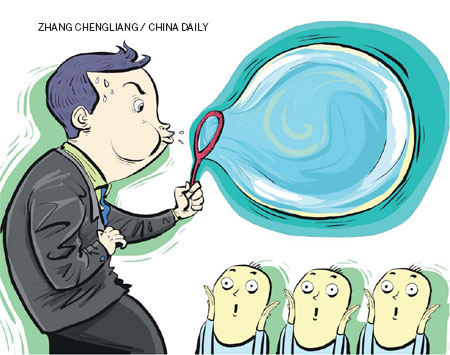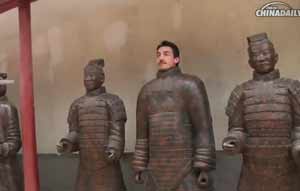Patent picture overblown
Updated: 2013-03-01 09:15
By Cong Cao (China Daily)
|
|||||||||||

China may lead the world in patents, but they are not necessarily innovative
Recent news that China's patent office is now the largest in the world prompted several breathless articles on how China had truly arrived on the innovation scene.
According to the World Intellectual Property Organization, China's State Intellectual Property Office received 526,412 invention patent applications in 2011, surpassing the United States by 23,000. The same year, China's patent office granted 172,113 invention patents, not far behind 238,323 in Japan and 224,505 in the US, indicating that China could soon top this list too.
Individual Chinese companies are competing fiercely in the global patent stakes. ZTE and Huawei Technologies, China's two largest telecommunication equipment makers, ranked first and third respectively in the number of international patent applications filed under the Patent Cooperation Treaty in 2011.
Patents are one of the most widely recognized measures of innovation, and these figures represent what is, on the surface, exciting news for a country that has grand ambitions to remodel itself as an innovation-driven economy.
However, just as the dramatic increase in the publication of Chinese-authored scientific journal papers in the past decade does not reflect new-found Chinese dominance in the world of science, the rise in patent applications is unlikely to mirror a wholesale transformation of products from being "Made in China" to "Invented in China".
First of all, the increase in Chinese patent applications is more a product of new government incentives than homegrown entrepreneurial zeal. It reflects the government's emphasis on scientific and technological development that called for a shift from following others to taking a lead through building an indigenous innovation capability.
As part of this technological drive, China initiated an IP-centric strategy that no longer merely tots up the number of published scientific journal articles in their evaluation of Chinese scientists and engineers. Patents are now at least as important a performance benchmark as scientific papers.
China's State Council published its Medium and Long-Term Plan for the Development of Science and Technology (up to 2020) in 2006. It called for China to enter the world's top five for the number of invention patents granted to its citizens. The government has even used monetary incentives to encourage technologists to apply for patents, in particular international patents.
Amid growing awareness of the importance of intellectual property rights, Chinese enterprises such as Huawei and ZTE have become globally competitive through active patent creation and utilization.
Founded in 1988 and based in Shenzhen, Huawei, a private manufacturer of broadband routers and switches, mandates in its charter to devote 10 percent of its revenue, estimated at $38 billion (29 billion euros) last year, to research and development. More than 40 percent of Huawei's employees are engaged in R&D, so it is no surprise that for several years the company has been a frontrunner in patent applications in China and abroad.
This has attracted the attention of its rivals, and recently a number of Chinese enterprises have been sued for IPR infringements by their international competitors.
Most of the legal battles have been fought as straightforward copyright violations or shanzhai (fake) products. However, in early 2003, Cisco Systems, the world's leading networking and communications manufacturer, whose revenue was $46 billion last year, accused Huawei of infringing on its patents and illegally copying source code used in its routers and switches. The case was settled with Huawei voluntarily withdrawing the products from the market.
The case was brought up again conspicuously in the US Congress's recent investigation into Huawei's business in the US, along with that of ZTE. Cisco's obvious resentment of Huawei, now a formidable challenger, can largely be attributed to Huawei's burgeoning technological sophistication.
However, Huawei and ZTE, also a Shenzhen-based telecommunications company, are the exception to the norm, a reality captured by central government guidelines issued in early February that urged enterprises to make more concerted efforts to "improve and innovate".
The statement published online called on large and medium-sized industrial enterprises to increase their R&D investment to 1.5 percent of their main business revenues, in addition to doubling the number of patent applications they typically file.
It explained the request by saying: "China's innovation is poor and lacks core technology with independent intellectual property rights", and that "the current mechanism has restricted innovation".
Also, Huawei and ZTE could not even sneak onto the 2012 Thomson Reuters list of Top 100 Global Innovators, for which the four criteria are all patent-related - overall patent volume, patent grant success rate, global reach of the portfolio and patent influence as evidenced by citations.
As a whole, China has witnessed phenomenal growth in its patent stocks. Between 2001 and 2010, patent applications had risen at an average annual rate of more than 20 percent, of which invention patent applications were up 28 percent year-on-year.
But domestic inventors are still more likely to file applications for utility model and design patents, or innovations of incremental improvements over existing ones. Even with strong growth over the past decade, invention patent applications still only account for one third of the total.
Furthermore, of about 2.3 million invention patent applications filed in China since 1990, 38 percent came from overseas entities, most likely multinational corporations, and only 28 percent from domestic companies. Similarly, of some 720,000 invention patents granted by China's patent office, more than half have been awarded to non-Chinese applicants.
These statistics reflect that Chinese academic institutions have applied for and now own a significant number of invention patents. Unfortunately, the technology transfer rate - the frequency with which inventions borne out of academic research reach the commercial marketplace - at Chinese universities and research institutes are as low as 10 percent. Thus, most of the patented technologies are imprisoned in the ivory tower.
In other words, patents have yet to generate significant economic benefit for China, and advanced technologies have still to be converted into competitive products capable of shaking up markets and competing internationally. China may be inventive but not necessarily innovative.
This also points to another inconvenient truth. With patents becoming a new yardstick for performance evaluation, many Chinese scientists and engineers have filed a patent application for the sake of it, rather than considering whether or not it is of real value. Doing so has wasted China's increasing, but still scarce, R&D resources.
It is no wonder that, barring notable exceptions, Chinese enterprises still rely upon foreign sources for core technologies, the Achilles' heel that the Chinese government's 15-year medium and long-term plan tries to strengthen. Indeed, according to a recent World Bank study, in 2009, China had a $10.6 billion deficit in its intellectual property balance of payments based on royalties and license fees.
So, by some measure, the seemingly positive patent statistics issued by the World Intellectual Property Organization are in fact worrisome. They are reflective of structural flaws in the Chinese system - the higher the number of patent applications, the more wasteful the spending by technologists at Chinese enterprises, and especially by academic institutions that generate patents with little real-world use.
Time will tell whether China is experiencing a patent bubble to follow its soon-to-burst journal publication bubble.
The author is a senior fellow at the China Policy Institute and an associate professor and reader at the School of Contemporary Chinese Studies, the University of Nottingham. The views do not necessarily reflect those of China Daily.
(China Daily 03/01/2013 page9)
Today's Top News
List of approved GM food clarified
ID checks for express deliveries in Guangdong
Govt to expand elderly care
University asks freshmen to sign suicide disclaimer
Tibet gears up for new climbing season
Media asked to promote Sino-Indian ties
Shots fired at Washington Navy Yard
Minimum growth rate set at 7%
Hot Topics
Lunar probe , China growth forecasts, Emission rules get tougher, China seen through 'colored lens', International board,
Editor's Picks

|

|

|

|

|

|





